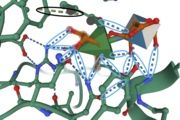Sandbox Reserved 1692
From Proteopedia
(Difference between revisions)
| Line 5: | Line 5: | ||
== Function of your protein == | == Function of your protein == | ||
| - | This enzyme, L-rhamnose- α-1,4-D-glucuronate lyase (FoRham1), is derived from the fungus ''Fusarium oxysporum'' and is a helpful tool for determining the structure and function of Gum Arabic (GA) to create potential agents to degrade GA more effectively. When the substrate GA is bound to FoRham1, the nonreducing ends of the glycosidic linkages are broken, releasing L-rhamnose (Rha) caps from GA <ref name="Kondo" />. Enzymes that can react with glycosidic linkages of certain carbohydrates can be useful in determining the structure, function, and mechanism of these carbohydrates, giving scientists the tools to manipulate their physical properties for further application to understand their breakdown. Determining this mechanism will give researchers a better understanding of how to degrade GA efficiently. Specifically, I focused on the mutant H105F, which has a PDB file of 7ESN. | + | This enzyme, L-rhamnose- α-1,4-D-glucuronate lyase (FoRham1), is derived from the fungus ''Fusarium oxysporum'' and is a helpful tool for determining the structure and function of Gum Arabic (GA) to create potential agents to degrade GA more effectively. When the substrate GA is bound to FoRham1, the nonreducing ends of the glycosidic linkages are broken, releasing L-rhamnose (Rha) caps from GA <ref name="Kondo" />. Enzymes that can react with glycosidic linkages of certain carbohydrates can be useful in determining the structure, function, and mechanism of these carbohydrates, giving scientists the tools to manipulate their physical properties for further application to understand their breakdown. GA degrading specific enzymes are classified as glycoside hydrolases <ref name="Kondo" />. Determining this mechanism will give researchers a better understanding of how to degrade GA efficiently. Specifically, I focused on the mutant H105F, which has a PDB file of 7ESN. |
Shown here is the enzyme <scene name='89/892735/Protein_view_2/3'>with bound ligand </scene> using N->C coloring. | Shown here is the enzyme <scene name='89/892735/Protein_view_2/3'>with bound ligand </scene> using N->C coloring. | ||
== Biological relevance and broader implications == | == Biological relevance and broader implications == | ||
Revision as of 22:39, 8 December 2021
| This Sandbox is Reserved from 10/01/2021 through 01/01//2022 for use in Biochemistry taught by Bonnie Hall at Grand View University, Des Moines, USA. This reservation includes Sandbox Reserved 1690 through Sandbox Reserved 1699. |
To get started:
More help: Help:Editing |
Structure and Function of FoRham1
| |||||||||||
References
- ↑ 1.0 1.1 1.2 1.3 Kondo T, Kichijo M, Maruta A, Nakaya M, Takenaka S, Arakawa T, Fushinobu S, Sakamoto T. Structural and functional analysis of gum arabic l-rhamnose-alpha-1,4-d-glucuronate lyase establishes a novel polysaccharide lyase family. J Biol Chem. 2021 Jul 22:101001. doi: 10.1016/j.jbc.2021.101001. PMID:34303708 doi:http://dx.doi.org/10.1016/j.jbc.2021.101001

